A Comprehensive Analysis of the UNFCCC, Climate Change, and Policies
VerifiedAdded on 2023/01/16
|14
|3765
|30
Essay
AI Summary
This essay provides a comprehensive analysis of the United Nations Framework Convention on Climate Change (UNFCCC). It begins by defining climate change and the UNFCCC's role in addressing it, referencing specific articles and objectives. The essay then delves into the UNFCCC's objectives, which include stabilizing greenhouse gas concentrations and promoting economic development while mitigating emissions. It explores the decision-making parameters, including the COP, CMA, CMP, SBSTA, and SBI, as well as constituted bodies. Furthermore, it examines various policy instruments employed by the UNFCCC, such as direct regulation, carbon pricing, tradable permits, voluntary agreements, and subsidies, highlighting their roles in achieving the convention's goals. The analysis draws on the UNFCCC document, related resources, and the IPCC Synthesis Report, offering a detailed overview of the convention's structure, functions, and impact on global climate change efforts.
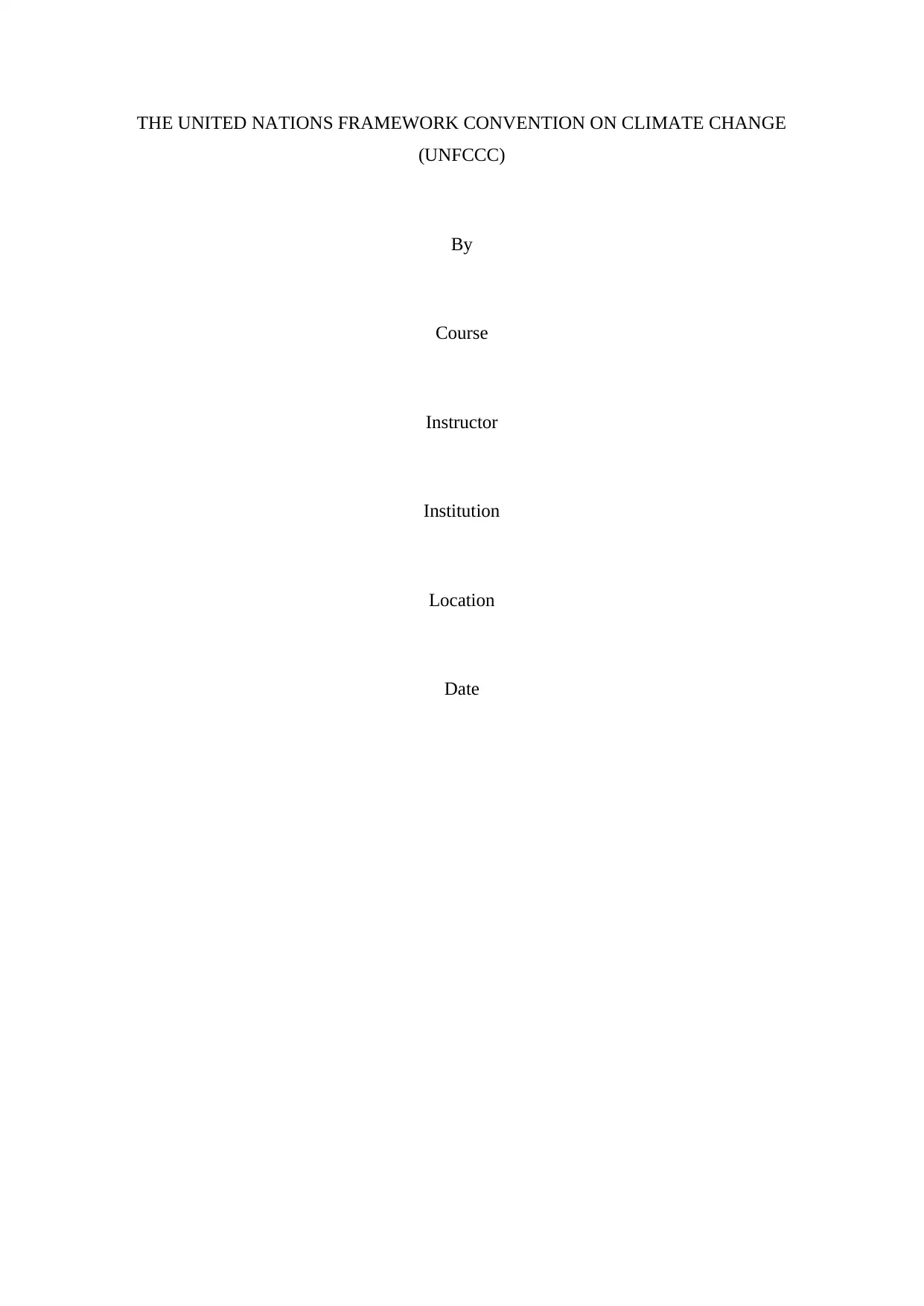
THE UNITED NATIONS FRAMEWORK CONVENTION ON CLIMATE CHANGE
(UNFCCC)
By
Course
Instructor
Institution
Location
Date
(UNFCCC)
By
Course
Instructor
Institution
Location
Date
Paraphrase This Document
Need a fresh take? Get an instant paraphrase of this document with our AI Paraphraser
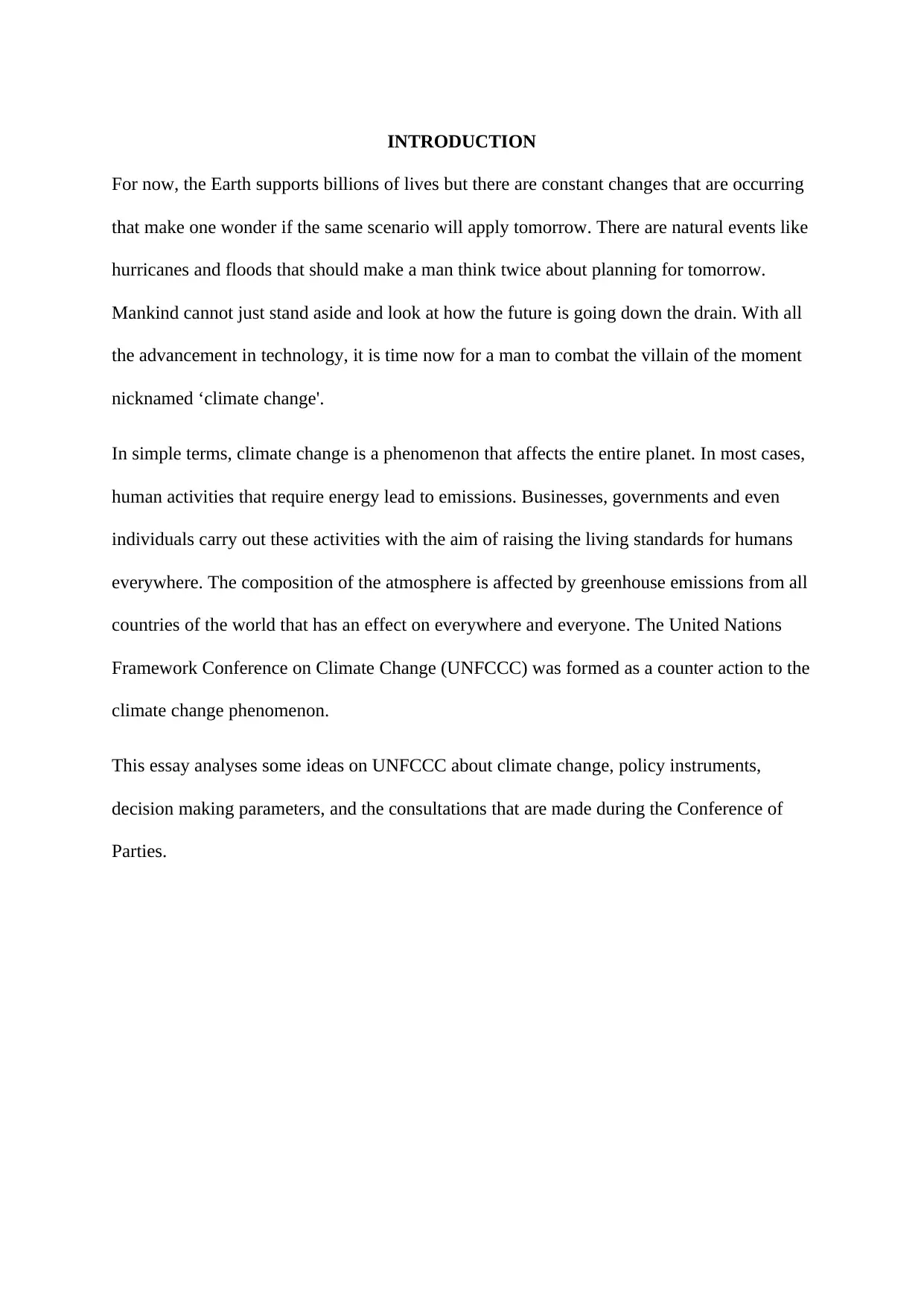
INTRODUCTION
For now, the Earth supports billions of lives but there are constant changes that are occurring
that make one wonder if the same scenario will apply tomorrow. There are natural events like
hurricanes and floods that should make a man think twice about planning for tomorrow.
Mankind cannot just stand aside and look at how the future is going down the drain. With all
the advancement in technology, it is time now for a man to combat the villain of the moment
nicknamed ‘climate change'.
In simple terms, climate change is a phenomenon that affects the entire planet. In most cases,
human activities that require energy lead to emissions. Businesses, governments and even
individuals carry out these activities with the aim of raising the living standards for humans
everywhere. The composition of the atmosphere is affected by greenhouse emissions from all
countries of the world that has an effect on everywhere and everyone. The United Nations
Framework Conference on Climate Change (UNFCCC) was formed as a counter action to the
climate change phenomenon.
This essay analyses some ideas on UNFCCC about climate change, policy instruments,
decision making parameters, and the consultations that are made during the Conference of
Parties.
For now, the Earth supports billions of lives but there are constant changes that are occurring
that make one wonder if the same scenario will apply tomorrow. There are natural events like
hurricanes and floods that should make a man think twice about planning for tomorrow.
Mankind cannot just stand aside and look at how the future is going down the drain. With all
the advancement in technology, it is time now for a man to combat the villain of the moment
nicknamed ‘climate change'.
In simple terms, climate change is a phenomenon that affects the entire planet. In most cases,
human activities that require energy lead to emissions. Businesses, governments and even
individuals carry out these activities with the aim of raising the living standards for humans
everywhere. The composition of the atmosphere is affected by greenhouse emissions from all
countries of the world that has an effect on everywhere and everyone. The United Nations
Framework Conference on Climate Change (UNFCCC) was formed as a counter action to the
climate change phenomenon.
This essay analyses some ideas on UNFCCC about climate change, policy instruments,
decision making parameters, and the consultations that are made during the Conference of
Parties.
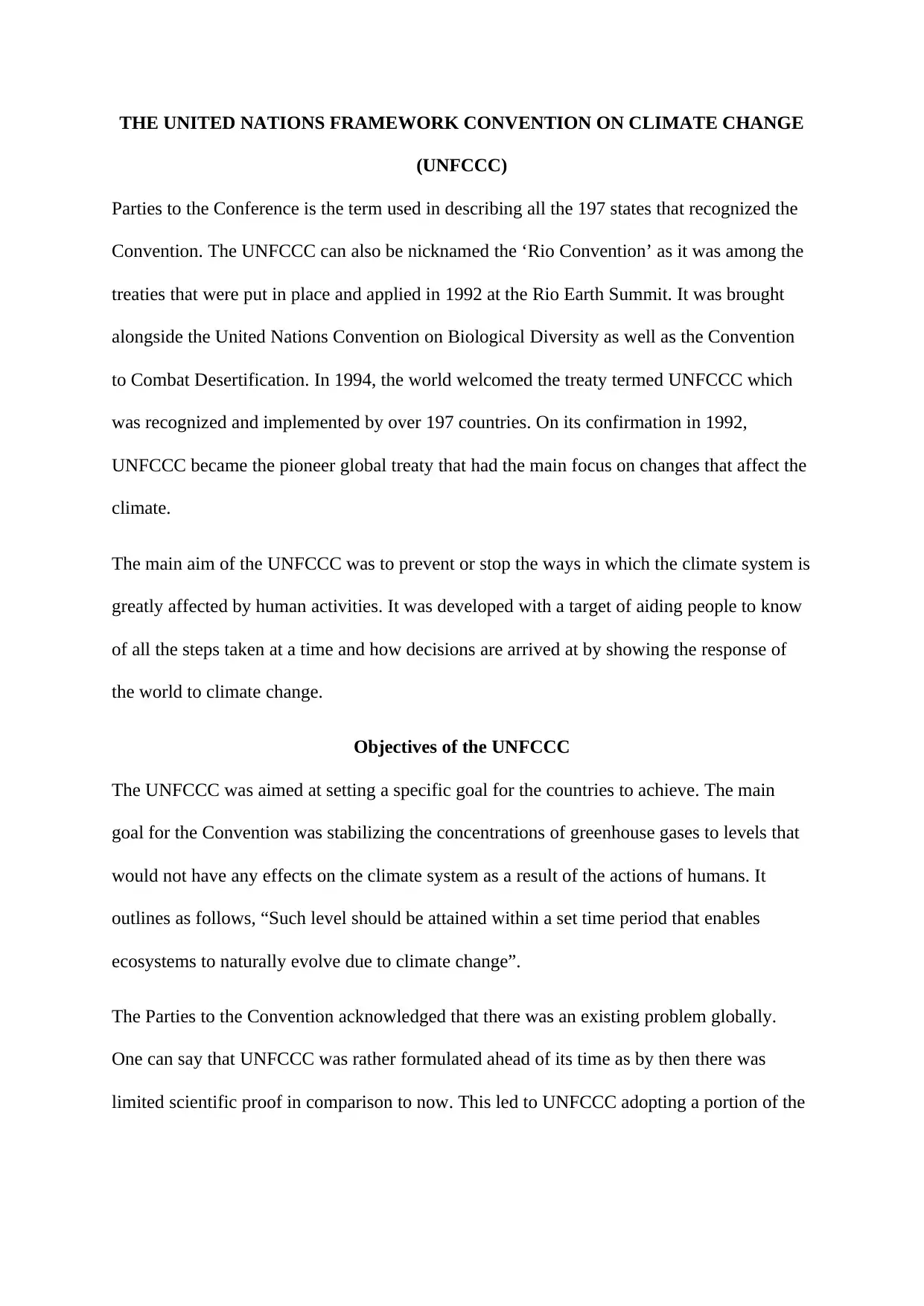
THE UNITED NATIONS FRAMEWORK CONVENTION ON CLIMATE CHANGE
(UNFCCC)
Parties to the Conference is the term used in describing all the 197 states that recognized the
Convention. The UNFCCC can also be nicknamed the ‘Rio Convention’ as it was among the
treaties that were put in place and applied in 1992 at the Rio Earth Summit. It was brought
alongside the United Nations Convention on Biological Diversity as well as the Convention
to Combat Desertification. In 1994, the world welcomed the treaty termed UNFCCC which
was recognized and implemented by over 197 countries. On its confirmation in 1992,
UNFCCC became the pioneer global treaty that had the main focus on changes that affect the
climate.
The main aim of the UNFCCC was to prevent or stop the ways in which the climate system is
greatly affected by human activities. It was developed with a target of aiding people to know
of all the steps taken at a time and how decisions are arrived at by showing the response of
the world to climate change.
Objectives of the UNFCCC
The UNFCCC was aimed at setting a specific goal for the countries to achieve. The main
goal for the Convention was stabilizing the concentrations of greenhouse gases to levels that
would not have any effects on the climate system as a result of the actions of humans. It
outlines as follows, “Such level should be attained within a set time period that enables
ecosystems to naturally evolve due to climate change”.
The Parties to the Convention acknowledged that there was an existing problem globally.
One can say that UNFCCC was rather formulated ahead of its time as by then there was
limited scientific proof in comparison to now. This led to UNFCCC adopting a portion of the
(UNFCCC)
Parties to the Conference is the term used in describing all the 197 states that recognized the
Convention. The UNFCCC can also be nicknamed the ‘Rio Convention’ as it was among the
treaties that were put in place and applied in 1992 at the Rio Earth Summit. It was brought
alongside the United Nations Convention on Biological Diversity as well as the Convention
to Combat Desertification. In 1994, the world welcomed the treaty termed UNFCCC which
was recognized and implemented by over 197 countries. On its confirmation in 1992,
UNFCCC became the pioneer global treaty that had the main focus on changes that affect the
climate.
The main aim of the UNFCCC was to prevent or stop the ways in which the climate system is
greatly affected by human activities. It was developed with a target of aiding people to know
of all the steps taken at a time and how decisions are arrived at by showing the response of
the world to climate change.
Objectives of the UNFCCC
The UNFCCC was aimed at setting a specific goal for the countries to achieve. The main
goal for the Convention was stabilizing the concentrations of greenhouse gases to levels that
would not have any effects on the climate system as a result of the actions of humans. It
outlines as follows, “Such level should be attained within a set time period that enables
ecosystems to naturally evolve due to climate change”.
The Parties to the Convention acknowledged that there was an existing problem globally.
One can say that UNFCCC was rather formulated ahead of its time as by then there was
limited scientific proof in comparison to now. This led to UNFCCC adopting a portion of the
⊘ This is a preview!⊘
Do you want full access?
Subscribe today to unlock all pages.

Trusted by 1+ million students worldwide
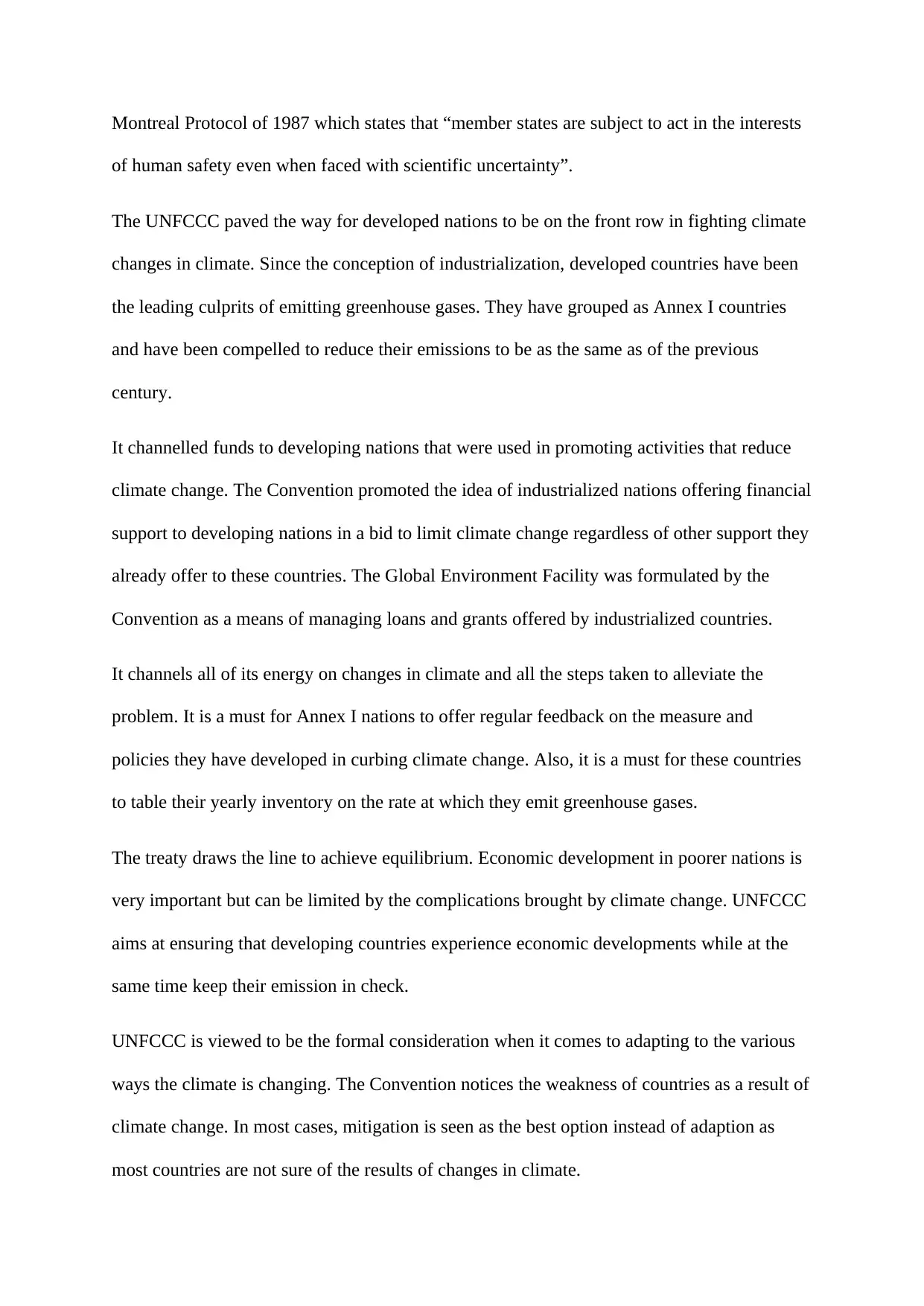
Montreal Protocol of 1987 which states that “member states are subject to act in the interests
of human safety even when faced with scientific uncertainty”.
The UNFCCC paved the way for developed nations to be on the front row in fighting climate
changes in climate. Since the conception of industrialization, developed countries have been
the leading culprits of emitting greenhouse gases. They have grouped as Annex I countries
and have been compelled to reduce their emissions to be as the same as of the previous
century.
It channelled funds to developing nations that were used in promoting activities that reduce
climate change. The Convention promoted the idea of industrialized nations offering financial
support to developing nations in a bid to limit climate change regardless of other support they
already offer to these countries. The Global Environment Facility was formulated by the
Convention as a means of managing loans and grants offered by industrialized countries.
It channels all of its energy on changes in climate and all the steps taken to alleviate the
problem. It is a must for Annex I nations to offer regular feedback on the measure and
policies they have developed in curbing climate change. Also, it is a must for these countries
to table their yearly inventory on the rate at which they emit greenhouse gases.
The treaty draws the line to achieve equilibrium. Economic development in poorer nations is
very important but can be limited by the complications brought by climate change. UNFCCC
aims at ensuring that developing countries experience economic developments while at the
same time keep their emission in check.
UNFCCC is viewed to be the formal consideration when it comes to adapting to the various
ways the climate is changing. The Convention notices the weakness of countries as a result of
climate change. In most cases, mitigation is seen as the best option instead of adaption as
most countries are not sure of the results of changes in climate.
of human safety even when faced with scientific uncertainty”.
The UNFCCC paved the way for developed nations to be on the front row in fighting climate
changes in climate. Since the conception of industrialization, developed countries have been
the leading culprits of emitting greenhouse gases. They have grouped as Annex I countries
and have been compelled to reduce their emissions to be as the same as of the previous
century.
It channelled funds to developing nations that were used in promoting activities that reduce
climate change. The Convention promoted the idea of industrialized nations offering financial
support to developing nations in a bid to limit climate change regardless of other support they
already offer to these countries. The Global Environment Facility was formulated by the
Convention as a means of managing loans and grants offered by industrialized countries.
It channels all of its energy on changes in climate and all the steps taken to alleviate the
problem. It is a must for Annex I nations to offer regular feedback on the measure and
policies they have developed in curbing climate change. Also, it is a must for these countries
to table their yearly inventory on the rate at which they emit greenhouse gases.
The treaty draws the line to achieve equilibrium. Economic development in poorer nations is
very important but can be limited by the complications brought by climate change. UNFCCC
aims at ensuring that developing countries experience economic developments while at the
same time keep their emission in check.
UNFCCC is viewed to be the formal consideration when it comes to adapting to the various
ways the climate is changing. The Convention notices the weakness of countries as a result of
climate change. In most cases, mitigation is seen as the best option instead of adaption as
most countries are not sure of the results of changes in climate.
Paraphrase This Document
Need a fresh take? Get an instant paraphrase of this document with our AI Paraphraser

Decision making parameters at the UNFCCC
These are institutions tasked with the mandate of formulating rules and offering direction to
the Parties in implementation of the Kyoto Protocol, Paris Agreement, and Convention.
The decision making parameters include:
Governing bodies and process management body
They include the COP to the Convention, the CMA for the Paris Agreement, the CMP for the
Kyoto Protocol and the Secretariat.
The COP is the chief decision making body of the UNFCCC. It plays the role in deciding all
decisions in regards to the Convention. Every member state that is a signatory to the
Convention must be present during every COP. In this convention, there is a review of what
to implement and all the legal instruments like administrative and institutional arrangements
that affect the COP decision making role. The COP serves as the congregation of the parties
to the Kyoto Protocol (CMP) takes oversight and decision making a role in the
implementation process of the Protocol. The COP serves as the congregation of Parties to the
Paris Agreement (CMA) plays an oversight and decision making role in the implementing the
Agreement. The Bureau of the COP, CMA and CMP play a supportive role to the duties of
the governing bodies by providing guidance and advice concerning the work that is being
done under the Convention, the Paris agreement and the Protocol.
The UNFCCC secretariat forms the ground for the technical know-how and organizational
support to the negotiations of UNFCCC. It also facilitates the passing of information that is
authoritative regarding the Kyoto Protocol, Paris Agreement and implementation of the
Convention. Such information is vital as it may contain data on effective implementation of
new ways of mitigating changes in climate and enhancing development that is sustainable.
These are institutions tasked with the mandate of formulating rules and offering direction to
the Parties in implementation of the Kyoto Protocol, Paris Agreement, and Convention.
The decision making parameters include:
Governing bodies and process management body
They include the COP to the Convention, the CMA for the Paris Agreement, the CMP for the
Kyoto Protocol and the Secretariat.
The COP is the chief decision making body of the UNFCCC. It plays the role in deciding all
decisions in regards to the Convention. Every member state that is a signatory to the
Convention must be present during every COP. In this convention, there is a review of what
to implement and all the legal instruments like administrative and institutional arrangements
that affect the COP decision making role. The COP serves as the congregation of the parties
to the Kyoto Protocol (CMP) takes oversight and decision making a role in the
implementation process of the Protocol. The COP serves as the congregation of Parties to the
Paris Agreement (CMA) plays an oversight and decision making role in the implementing the
Agreement. The Bureau of the COP, CMA and CMP play a supportive role to the duties of
the governing bodies by providing guidance and advice concerning the work that is being
done under the Convention, the Paris agreement and the Protocol.
The UNFCCC secretariat forms the ground for the technical know-how and organizational
support to the negotiations of UNFCCC. It also facilitates the passing of information that is
authoritative regarding the Kyoto Protocol, Paris Agreement and implementation of the
Convention. Such information is vital as it may contain data on effective implementation of
new ways of mitigating changes in climate and enhancing development that is sustainable.
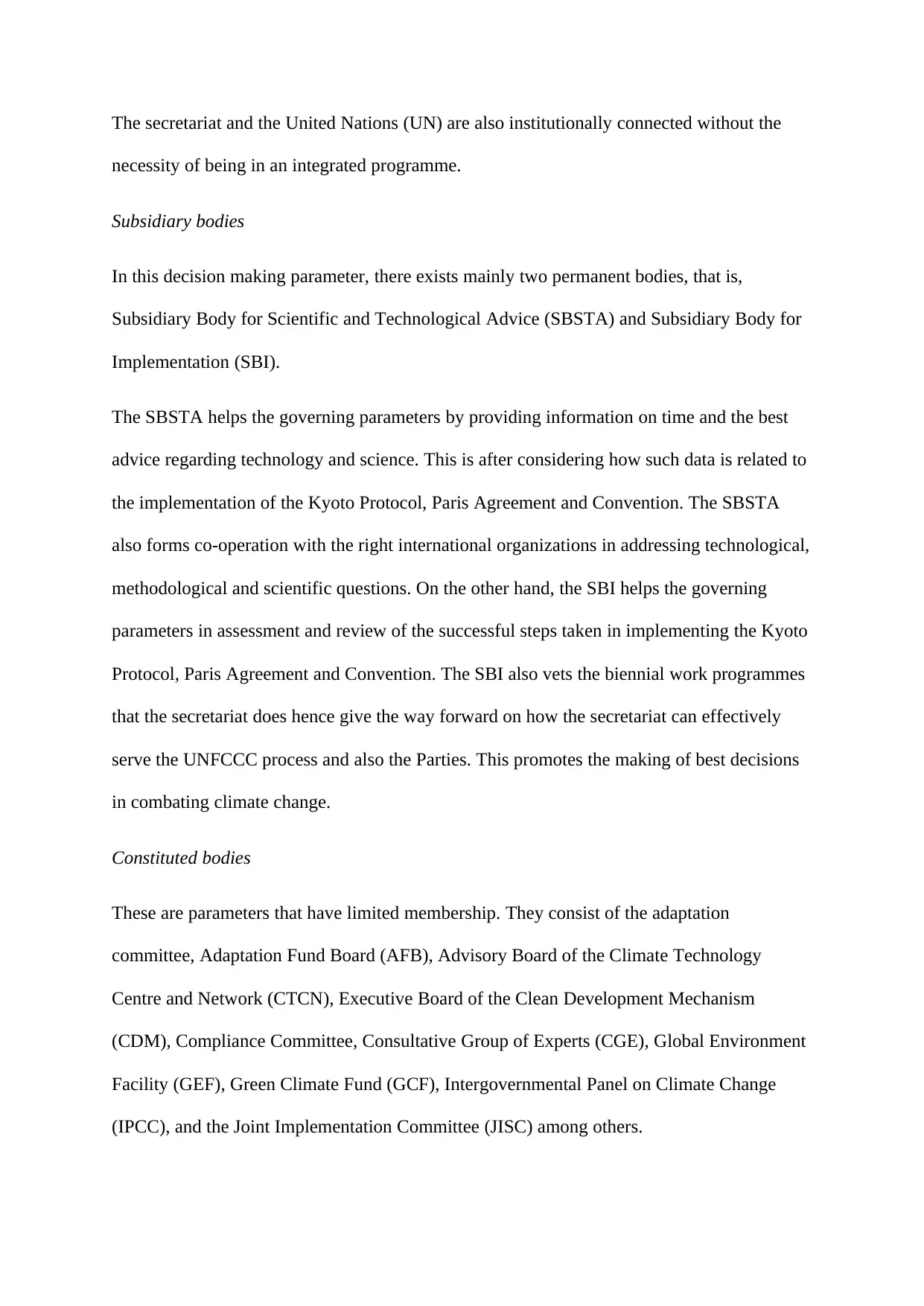
The secretariat and the United Nations (UN) are also institutionally connected without the
necessity of being in an integrated programme.
Subsidiary bodies
In this decision making parameter, there exists mainly two permanent bodies, that is,
Subsidiary Body for Scientific and Technological Advice (SBSTA) and Subsidiary Body for
Implementation (SBI).
The SBSTA helps the governing parameters by providing information on time and the best
advice regarding technology and science. This is after considering how such data is related to
the implementation of the Kyoto Protocol, Paris Agreement and Convention. The SBSTA
also forms co-operation with the right international organizations in addressing technological,
methodological and scientific questions. On the other hand, the SBI helps the governing
parameters in assessment and review of the successful steps taken in implementing the Kyoto
Protocol, Paris Agreement and Convention. The SBI also vets the biennial work programmes
that the secretariat does hence give the way forward on how the secretariat can effectively
serve the UNFCCC process and also the Parties. This promotes the making of best decisions
in combating climate change.
Constituted bodies
These are parameters that have limited membership. They consist of the adaptation
committee, Adaptation Fund Board (AFB), Advisory Board of the Climate Technology
Centre and Network (CTCN), Executive Board of the Clean Development Mechanism
(CDM), Compliance Committee, Consultative Group of Experts (CGE), Global Environment
Facility (GEF), Green Climate Fund (GCF), Intergovernmental Panel on Climate Change
(IPCC), and the Joint Implementation Committee (JISC) among others.
necessity of being in an integrated programme.
Subsidiary bodies
In this decision making parameter, there exists mainly two permanent bodies, that is,
Subsidiary Body for Scientific and Technological Advice (SBSTA) and Subsidiary Body for
Implementation (SBI).
The SBSTA helps the governing parameters by providing information on time and the best
advice regarding technology and science. This is after considering how such data is related to
the implementation of the Kyoto Protocol, Paris Agreement and Convention. The SBSTA
also forms co-operation with the right international organizations in addressing technological,
methodological and scientific questions. On the other hand, the SBI helps the governing
parameters in assessment and review of the successful steps taken in implementing the Kyoto
Protocol, Paris Agreement and Convention. The SBI also vets the biennial work programmes
that the secretariat does hence give the way forward on how the secretariat can effectively
serve the UNFCCC process and also the Parties. This promotes the making of best decisions
in combating climate change.
Constituted bodies
These are parameters that have limited membership. They consist of the adaptation
committee, Adaptation Fund Board (AFB), Advisory Board of the Climate Technology
Centre and Network (CTCN), Executive Board of the Clean Development Mechanism
(CDM), Compliance Committee, Consultative Group of Experts (CGE), Global Environment
Facility (GEF), Green Climate Fund (GCF), Intergovernmental Panel on Climate Change
(IPCC), and the Joint Implementation Committee (JISC) among others.
⊘ This is a preview!⊘
Do you want full access?
Subscribe today to unlock all pages.

Trusted by 1+ million students worldwide
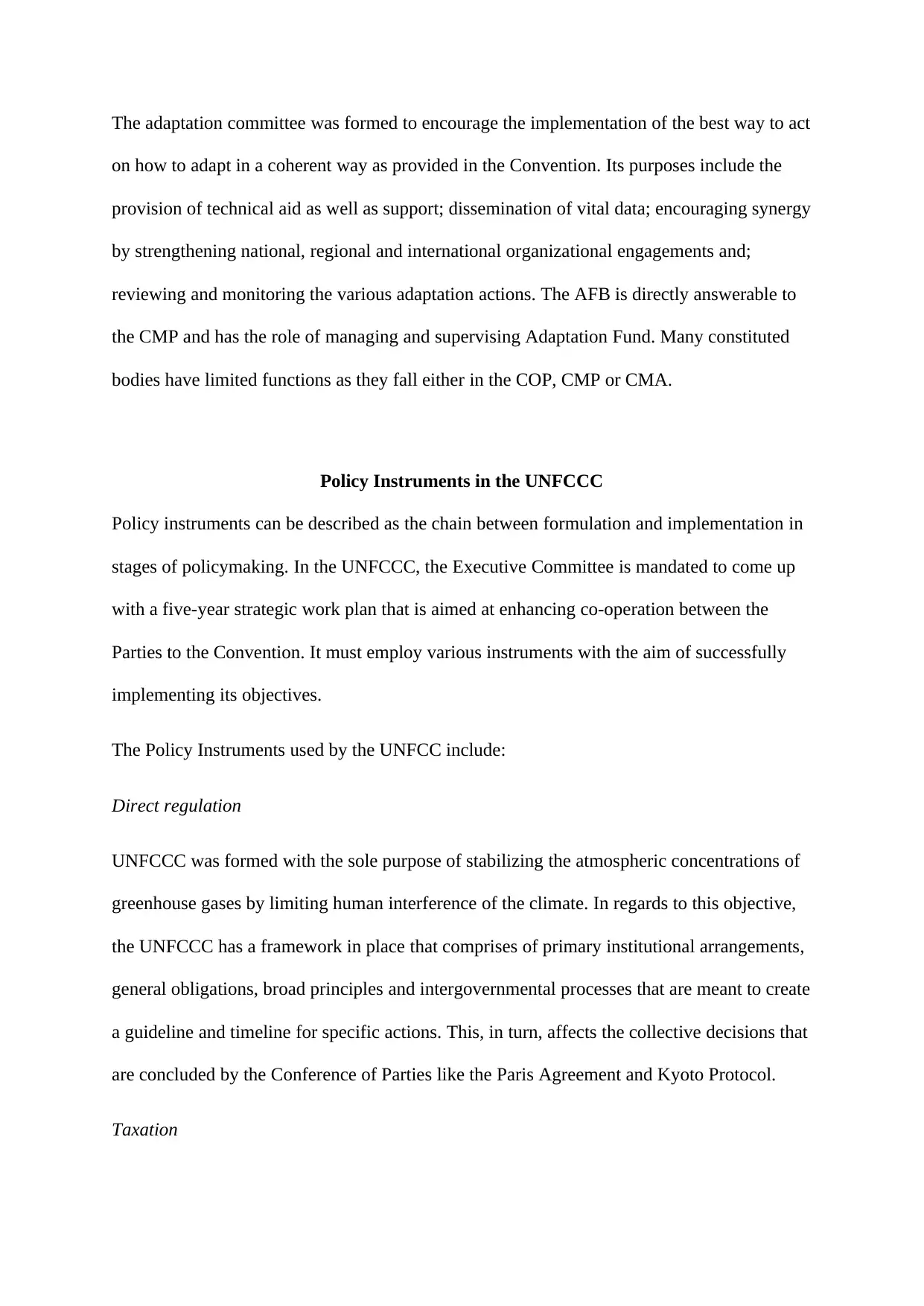
The adaptation committee was formed to encourage the implementation of the best way to act
on how to adapt in a coherent way as provided in the Convention. Its purposes include the
provision of technical aid as well as support; dissemination of vital data; encouraging synergy
by strengthening national, regional and international organizational engagements and;
reviewing and monitoring the various adaptation actions. The AFB is directly answerable to
the CMP and has the role of managing and supervising Adaptation Fund. Many constituted
bodies have limited functions as they fall either in the COP, CMP or CMA.
Policy Instruments in the UNFCCC
Policy instruments can be described as the chain between formulation and implementation in
stages of policymaking. In the UNFCCC, the Executive Committee is mandated to come up
with a five-year strategic work plan that is aimed at enhancing co-operation between the
Parties to the Convention. It must employ various instruments with the aim of successfully
implementing its objectives.
The Policy Instruments used by the UNFCC include:
Direct regulation
UNFCCC was formed with the sole purpose of stabilizing the atmospheric concentrations of
greenhouse gases by limiting human interference of the climate. In regards to this objective,
the UNFCCC has a framework in place that comprises of primary institutional arrangements,
general obligations, broad principles and intergovernmental processes that are meant to create
a guideline and timeline for specific actions. This, in turn, affects the collective decisions that
are concluded by the Conference of Parties like the Paris Agreement and Kyoto Protocol.
Taxation
on how to adapt in a coherent way as provided in the Convention. Its purposes include the
provision of technical aid as well as support; dissemination of vital data; encouraging synergy
by strengthening national, regional and international organizational engagements and;
reviewing and monitoring the various adaptation actions. The AFB is directly answerable to
the CMP and has the role of managing and supervising Adaptation Fund. Many constituted
bodies have limited functions as they fall either in the COP, CMP or CMA.
Policy Instruments in the UNFCCC
Policy instruments can be described as the chain between formulation and implementation in
stages of policymaking. In the UNFCCC, the Executive Committee is mandated to come up
with a five-year strategic work plan that is aimed at enhancing co-operation between the
Parties to the Convention. It must employ various instruments with the aim of successfully
implementing its objectives.
The Policy Instruments used by the UNFCC include:
Direct regulation
UNFCCC was formed with the sole purpose of stabilizing the atmospheric concentrations of
greenhouse gases by limiting human interference of the climate. In regards to this objective,
the UNFCCC has a framework in place that comprises of primary institutional arrangements,
general obligations, broad principles and intergovernmental processes that are meant to create
a guideline and timeline for specific actions. This, in turn, affects the collective decisions that
are concluded by the Conference of Parties like the Paris Agreement and Kyoto Protocol.
Taxation
Paraphrase This Document
Need a fresh take? Get an instant paraphrase of this document with our AI Paraphraser
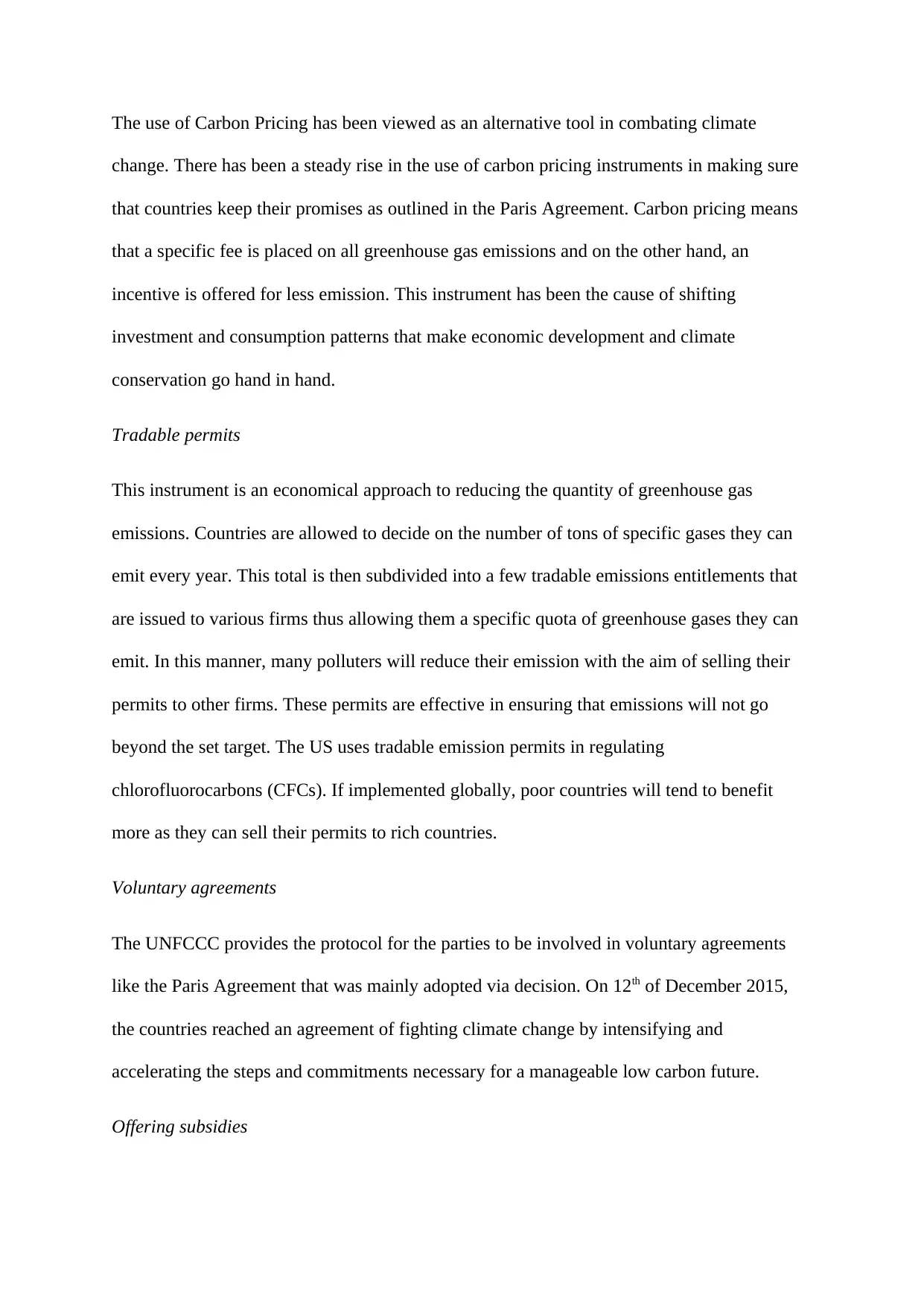
The use of Carbon Pricing has been viewed as an alternative tool in combating climate
change. There has been a steady rise in the use of carbon pricing instruments in making sure
that countries keep their promises as outlined in the Paris Agreement. Carbon pricing means
that a specific fee is placed on all greenhouse gas emissions and on the other hand, an
incentive is offered for less emission. This instrument has been the cause of shifting
investment and consumption patterns that make economic development and climate
conservation go hand in hand.
Tradable permits
This instrument is an economical approach to reducing the quantity of greenhouse gas
emissions. Countries are allowed to decide on the number of tons of specific gases they can
emit every year. This total is then subdivided into a few tradable emissions entitlements that
are issued to various firms thus allowing them a specific quota of greenhouse gases they can
emit. In this manner, many polluters will reduce their emission with the aim of selling their
permits to other firms. These permits are effective in ensuring that emissions will not go
beyond the set target. The US uses tradable emission permits in regulating
chlorofluorocarbons (CFCs). If implemented globally, poor countries will tend to benefit
more as they can sell their permits to rich countries.
Voluntary agreements
The UNFCCC provides the protocol for the parties to be involved in voluntary agreements
like the Paris Agreement that was mainly adopted via decision. On 12th of December 2015,
the countries reached an agreement of fighting climate change by intensifying and
accelerating the steps and commitments necessary for a manageable low carbon future.
Offering subsidies
change. There has been a steady rise in the use of carbon pricing instruments in making sure
that countries keep their promises as outlined in the Paris Agreement. Carbon pricing means
that a specific fee is placed on all greenhouse gas emissions and on the other hand, an
incentive is offered for less emission. This instrument has been the cause of shifting
investment and consumption patterns that make economic development and climate
conservation go hand in hand.
Tradable permits
This instrument is an economical approach to reducing the quantity of greenhouse gas
emissions. Countries are allowed to decide on the number of tons of specific gases they can
emit every year. This total is then subdivided into a few tradable emissions entitlements that
are issued to various firms thus allowing them a specific quota of greenhouse gases they can
emit. In this manner, many polluters will reduce their emission with the aim of selling their
permits to other firms. These permits are effective in ensuring that emissions will not go
beyond the set target. The US uses tradable emission permits in regulating
chlorofluorocarbons (CFCs). If implemented globally, poor countries will tend to benefit
more as they can sell their permits to rich countries.
Voluntary agreements
The UNFCCC provides the protocol for the parties to be involved in voluntary agreements
like the Paris Agreement that was mainly adopted via decision. On 12th of December 2015,
the countries reached an agreement of fighting climate change by intensifying and
accelerating the steps and commitments necessary for a manageable low carbon future.
Offering subsidies
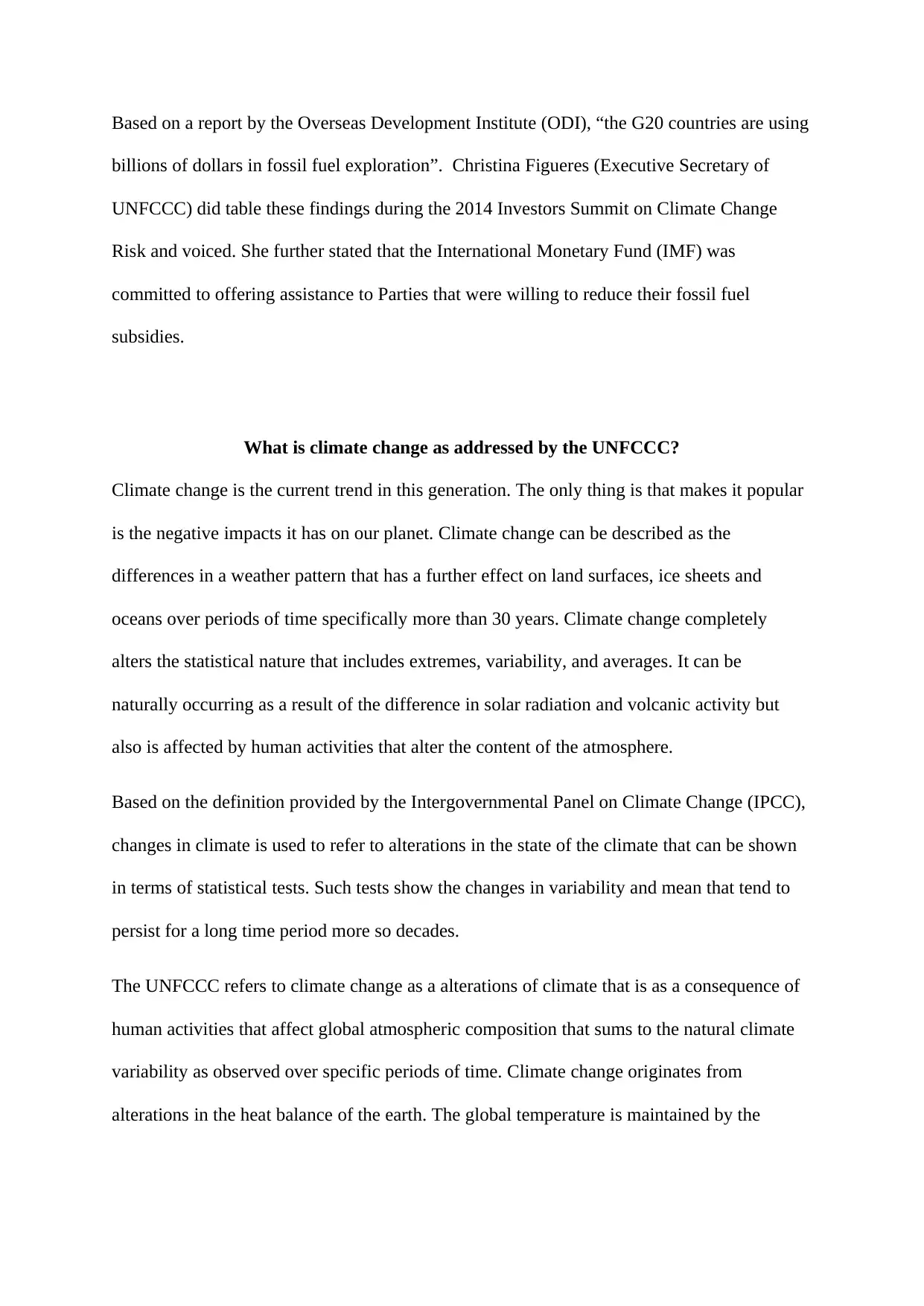
Based on a report by the Overseas Development Institute (ODI), “the G20 countries are using
billions of dollars in fossil fuel exploration”. Christina Figueres (Executive Secretary of
UNFCCC) did table these findings during the 2014 Investors Summit on Climate Change
Risk and voiced. She further stated that the International Monetary Fund (IMF) was
committed to offering assistance to Parties that were willing to reduce their fossil fuel
subsidies.
What is climate change as addressed by the UNFCCC?
Climate change is the current trend in this generation. The only thing is that makes it popular
is the negative impacts it has on our planet. Climate change can be described as the
differences in a weather pattern that has a further effect on land surfaces, ice sheets and
oceans over periods of time specifically more than 30 years. Climate change completely
alters the statistical nature that includes extremes, variability, and averages. It can be
naturally occurring as a result of the difference in solar radiation and volcanic activity but
also is affected by human activities that alter the content of the atmosphere.
Based on the definition provided by the Intergovernmental Panel on Climate Change (IPCC),
changes in climate is used to refer to alterations in the state of the climate that can be shown
in terms of statistical tests. Such tests show the changes in variability and mean that tend to
persist for a long time period more so decades.
The UNFCCC refers to climate change as a alterations of climate that is as a consequence of
human activities that affect global atmospheric composition that sums to the natural climate
variability as observed over specific periods of time. Climate change originates from
alterations in the heat balance of the earth. The global temperature is maintained by the
billions of dollars in fossil fuel exploration”. Christina Figueres (Executive Secretary of
UNFCCC) did table these findings during the 2014 Investors Summit on Climate Change
Risk and voiced. She further stated that the International Monetary Fund (IMF) was
committed to offering assistance to Parties that were willing to reduce their fossil fuel
subsidies.
What is climate change as addressed by the UNFCCC?
Climate change is the current trend in this generation. The only thing is that makes it popular
is the negative impacts it has on our planet. Climate change can be described as the
differences in a weather pattern that has a further effect on land surfaces, ice sheets and
oceans over periods of time specifically more than 30 years. Climate change completely
alters the statistical nature that includes extremes, variability, and averages. It can be
naturally occurring as a result of the difference in solar radiation and volcanic activity but
also is affected by human activities that alter the content of the atmosphere.
Based on the definition provided by the Intergovernmental Panel on Climate Change (IPCC),
changes in climate is used to refer to alterations in the state of the climate that can be shown
in terms of statistical tests. Such tests show the changes in variability and mean that tend to
persist for a long time period more so decades.
The UNFCCC refers to climate change as a alterations of climate that is as a consequence of
human activities that affect global atmospheric composition that sums to the natural climate
variability as observed over specific periods of time. Climate change originates from
alterations in the heat balance of the earth. The global temperature is maintained by the
⊘ This is a preview!⊘
Do you want full access?
Subscribe today to unlock all pages.

Trusted by 1+ million students worldwide
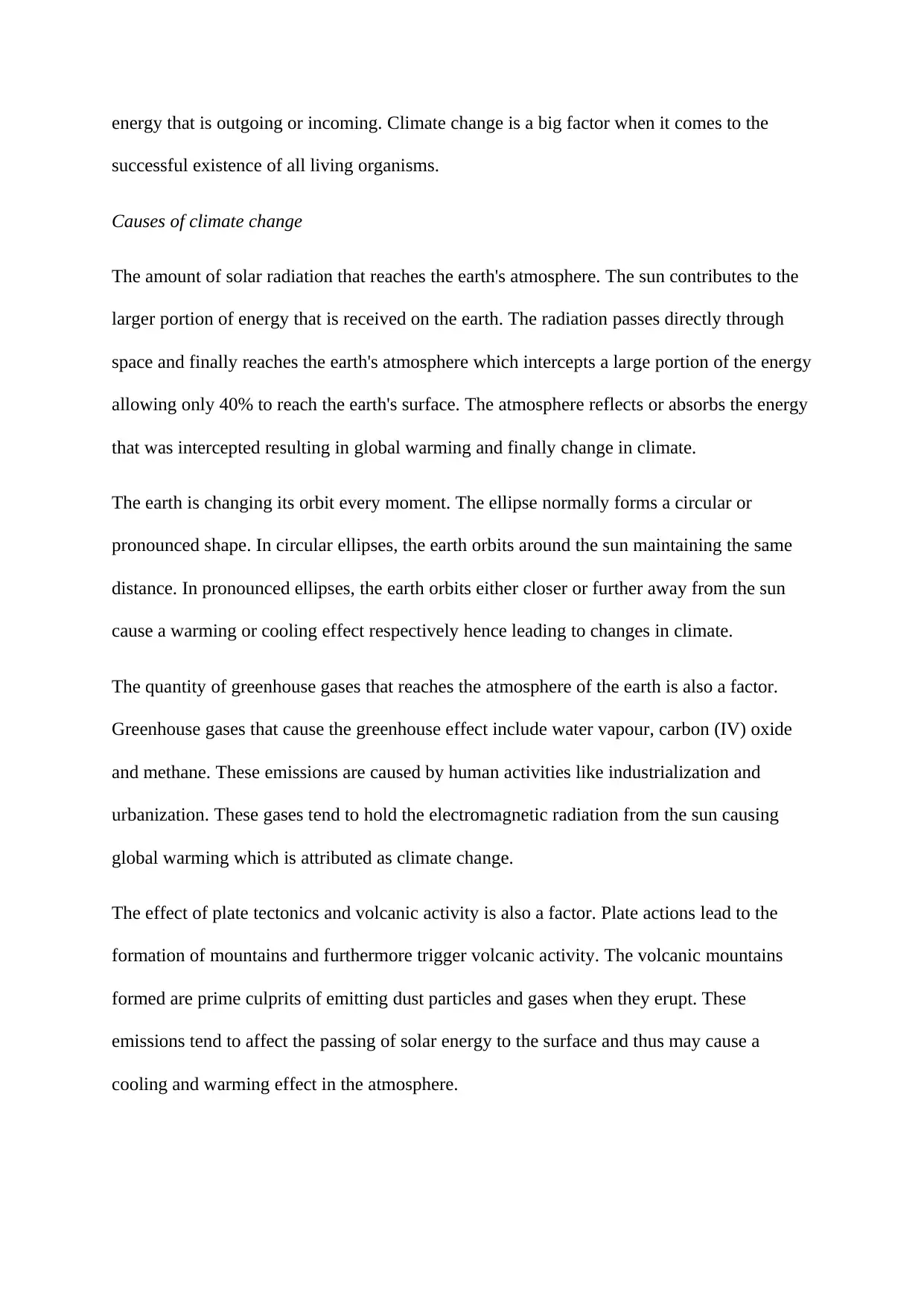
energy that is outgoing or incoming. Climate change is a big factor when it comes to the
successful existence of all living organisms.
Causes of climate change
The amount of solar radiation that reaches the earth's atmosphere. The sun contributes to the
larger portion of energy that is received on the earth. The radiation passes directly through
space and finally reaches the earth's atmosphere which intercepts a large portion of the energy
allowing only 40% to reach the earth's surface. The atmosphere reflects or absorbs the energy
that was intercepted resulting in global warming and finally change in climate.
The earth is changing its orbit every moment. The ellipse normally forms a circular or
pronounced shape. In circular ellipses, the earth orbits around the sun maintaining the same
distance. In pronounced ellipses, the earth orbits either closer or further away from the sun
cause a warming or cooling effect respectively hence leading to changes in climate.
The quantity of greenhouse gases that reaches the atmosphere of the earth is also a factor.
Greenhouse gases that cause the greenhouse effect include water vapour, carbon (IV) oxide
and methane. These emissions are caused by human activities like industrialization and
urbanization. These gases tend to hold the electromagnetic radiation from the sun causing
global warming which is attributed as climate change.
The effect of plate tectonics and volcanic activity is also a factor. Plate actions lead to the
formation of mountains and furthermore trigger volcanic activity. The volcanic mountains
formed are prime culprits of emitting dust particles and gases when they erupt. These
emissions tend to affect the passing of solar energy to the surface and thus may cause a
cooling and warming effect in the atmosphere.
successful existence of all living organisms.
Causes of climate change
The amount of solar radiation that reaches the earth's atmosphere. The sun contributes to the
larger portion of energy that is received on the earth. The radiation passes directly through
space and finally reaches the earth's atmosphere which intercepts a large portion of the energy
allowing only 40% to reach the earth's surface. The atmosphere reflects or absorbs the energy
that was intercepted resulting in global warming and finally change in climate.
The earth is changing its orbit every moment. The ellipse normally forms a circular or
pronounced shape. In circular ellipses, the earth orbits around the sun maintaining the same
distance. In pronounced ellipses, the earth orbits either closer or further away from the sun
cause a warming or cooling effect respectively hence leading to changes in climate.
The quantity of greenhouse gases that reaches the atmosphere of the earth is also a factor.
Greenhouse gases that cause the greenhouse effect include water vapour, carbon (IV) oxide
and methane. These emissions are caused by human activities like industrialization and
urbanization. These gases tend to hold the electromagnetic radiation from the sun causing
global warming which is attributed as climate change.
The effect of plate tectonics and volcanic activity is also a factor. Plate actions lead to the
formation of mountains and furthermore trigger volcanic activity. The volcanic mountains
formed are prime culprits of emitting dust particles and gases when they erupt. These
emissions tend to affect the passing of solar energy to the surface and thus may cause a
cooling and warming effect in the atmosphere.
Paraphrase This Document
Need a fresh take? Get an instant paraphrase of this document with our AI Paraphraser
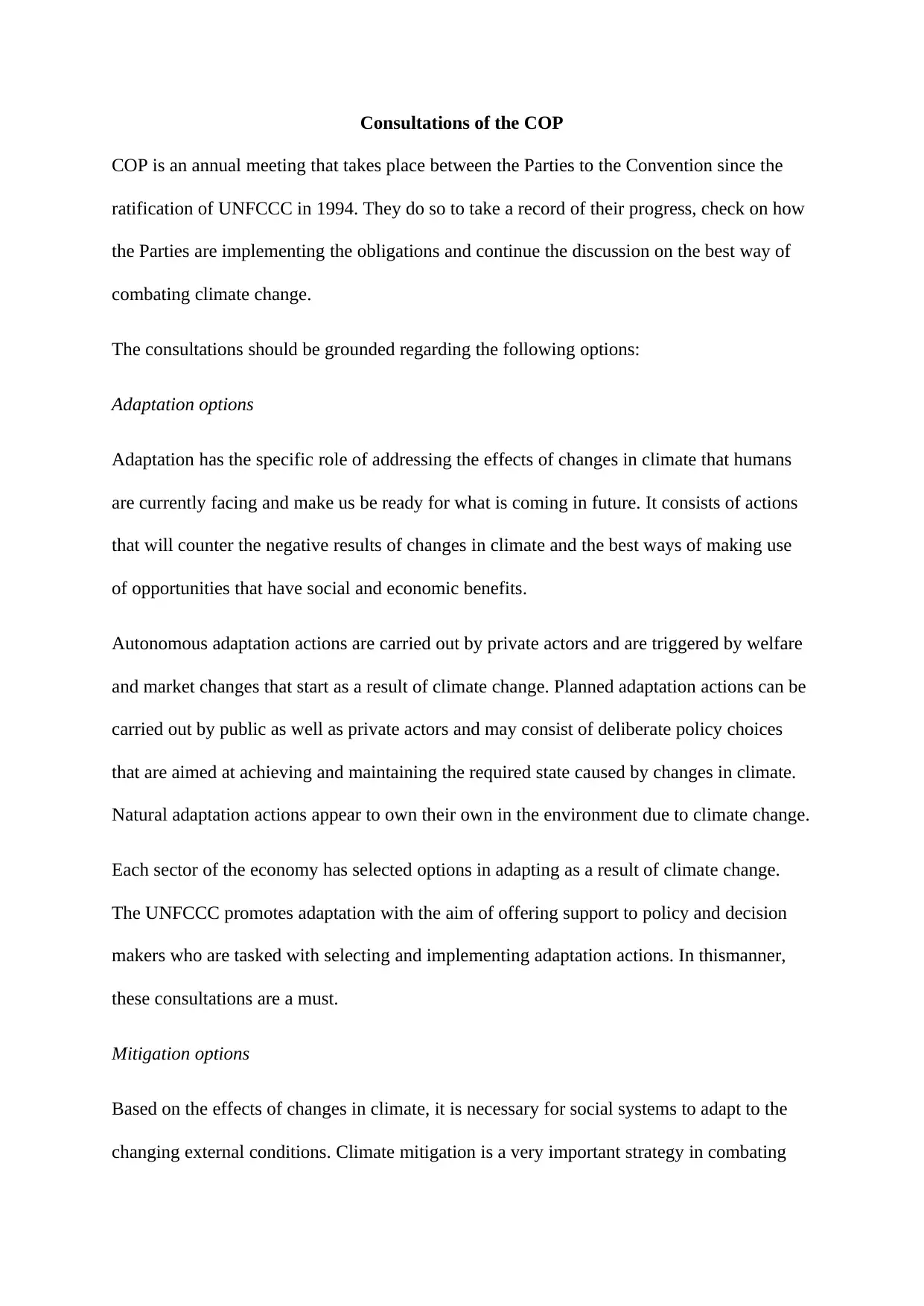
Consultations of the COP
COP is an annual meeting that takes place between the Parties to the Convention since the
ratification of UNFCCC in 1994. They do so to take a record of their progress, check on how
the Parties are implementing the obligations and continue the discussion on the best way of
combating climate change.
The consultations should be grounded regarding the following options:
Adaptation options
Adaptation has the specific role of addressing the effects of changes in climate that humans
are currently facing and make us be ready for what is coming in future. It consists of actions
that will counter the negative results of changes in climate and the best ways of making use
of opportunities that have social and economic benefits.
Autonomous adaptation actions are carried out by private actors and are triggered by welfare
and market changes that start as a result of climate change. Planned adaptation actions can be
carried out by public as well as private actors and may consist of deliberate policy choices
that are aimed at achieving and maintaining the required state caused by changes in climate.
Natural adaptation actions appear to own their own in the environment due to climate change.
Each sector of the economy has selected options in adapting as a result of climate change.
The UNFCCC promotes adaptation with the aim of offering support to policy and decision
makers who are tasked with selecting and implementing adaptation actions. In thismanner,
these consultations are a must.
Mitigation options
Based on the effects of changes in climate, it is necessary for social systems to adapt to the
changing external conditions. Climate mitigation is a very important strategy in combating
COP is an annual meeting that takes place between the Parties to the Convention since the
ratification of UNFCCC in 1994. They do so to take a record of their progress, check on how
the Parties are implementing the obligations and continue the discussion on the best way of
combating climate change.
The consultations should be grounded regarding the following options:
Adaptation options
Adaptation has the specific role of addressing the effects of changes in climate that humans
are currently facing and make us be ready for what is coming in future. It consists of actions
that will counter the negative results of changes in climate and the best ways of making use
of opportunities that have social and economic benefits.
Autonomous adaptation actions are carried out by private actors and are triggered by welfare
and market changes that start as a result of climate change. Planned adaptation actions can be
carried out by public as well as private actors and may consist of deliberate policy choices
that are aimed at achieving and maintaining the required state caused by changes in climate.
Natural adaptation actions appear to own their own in the environment due to climate change.
Each sector of the economy has selected options in adapting as a result of climate change.
The UNFCCC promotes adaptation with the aim of offering support to policy and decision
makers who are tasked with selecting and implementing adaptation actions. In thismanner,
these consultations are a must.
Mitigation options
Based on the effects of changes in climate, it is necessary for social systems to adapt to the
changing external conditions. Climate mitigation is a very important strategy in combating

climate change by trying to control the rate at which greenhouse gases are emitted into the
atmosphere. Mitigation has the target of reducing the rate at which global temperatures are
rising using strategies that are designed to reduce greenhouse gas from anthropogenic
emissions. Mitigation can also be arrived at by raising the levels of carbon sinks through
activities like reforestation.
CONCLUSION
The UNFCCC has big shoes to fill when it comes to fighting climate change. It should
guarantee the next generation that the Earth will still be in existence and fit for supporting life
in the coming decades. As documented in the essay, climate change is real and slowly
causing havoc in different parts of the world. It is time for the Parties to the Convention to
accept their roles in causing changes in climate and also try and control the human activities
that daily emit greenhouse gases to the atmosphere.
The UNFCCC has the power to even regulate the G20 of the world who lead in greenhouse
emissions in the world. What is left is the need to follow the guidelines provided by the
UNFCCC in trying to curb the rate at which there are changes in the climate. It should be
mandatory for all the nations of the world to adopt policies that are aimed at conserving the
environment.
A man should also embrace new technologies that cause less emission. Natural contributors
to climate change like solar radiation and volcanic eruptions cannot be controlled by human
and should therefore not be blamed for the mess man is making on the planet. It is time to
offer lasting solutions to this problem.
atmosphere. Mitigation has the target of reducing the rate at which global temperatures are
rising using strategies that are designed to reduce greenhouse gas from anthropogenic
emissions. Mitigation can also be arrived at by raising the levels of carbon sinks through
activities like reforestation.
CONCLUSION
The UNFCCC has big shoes to fill when it comes to fighting climate change. It should
guarantee the next generation that the Earth will still be in existence and fit for supporting life
in the coming decades. As documented in the essay, climate change is real and slowly
causing havoc in different parts of the world. It is time for the Parties to the Convention to
accept their roles in causing changes in climate and also try and control the human activities
that daily emit greenhouse gases to the atmosphere.
The UNFCCC has the power to even regulate the G20 of the world who lead in greenhouse
emissions in the world. What is left is the need to follow the guidelines provided by the
UNFCCC in trying to curb the rate at which there are changes in the climate. It should be
mandatory for all the nations of the world to adopt policies that are aimed at conserving the
environment.
A man should also embrace new technologies that cause less emission. Natural contributors
to climate change like solar radiation and volcanic eruptions cannot be controlled by human
and should therefore not be blamed for the mess man is making on the planet. It is time to
offer lasting solutions to this problem.
⊘ This is a preview!⊘
Do you want full access?
Subscribe today to unlock all pages.

Trusted by 1+ million students worldwide
1 out of 14
Related Documents
Your All-in-One AI-Powered Toolkit for Academic Success.
+13062052269
info@desklib.com
Available 24*7 on WhatsApp / Email
![[object Object]](/_next/static/media/star-bottom.7253800d.svg)
Unlock your academic potential
Copyright © 2020–2025 A2Z Services. All Rights Reserved. Developed and managed by ZUCOL.




